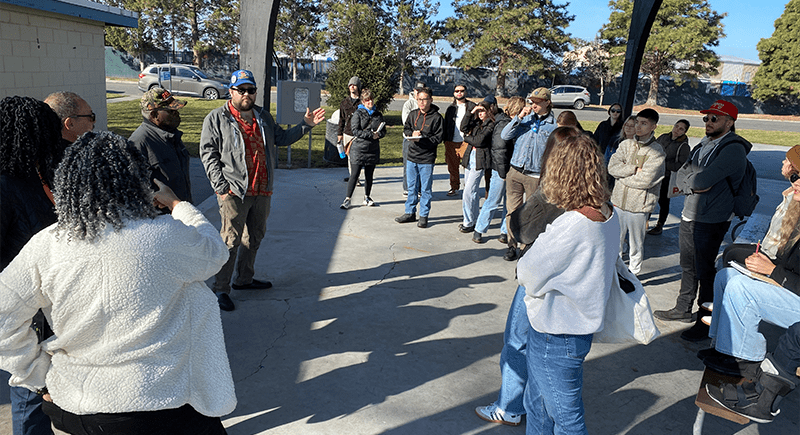
July 29, 2024 Cross-campus graduate course addresses infrastructural racism in east Pasco
A new cross-campus course between Washington State University Pullman and WSU Tri-Cities is enabling history and architecture graduate students to bring rarely told stories about east Pasco’s racial history to life.
The spring 2024 course, Issues in Architecture (Architecture 542), examines infrastructural racism by studying how the built environment shapes communities in relationship with discrimination. After weeks of preparation in the classroom, 24 graduate students from WSU Pullman spent a day in the Tri-Cities learning the history of marginalized populations, meeting with community members, and learning about ongoing issues that have been ignored over time in east Pasco.
The course began as an idea proposed in 2022 by WSU Tri-Cities College of Arts and Sciences Professor Robert Franklin in partnership with WSU Pullman School of Design and Construction Professor Phil Gruen.
“[This class] represents the strengths that we don’t always utilize as a land grant institution: the communities that our campuses are in and the ‘town-gown’ relationships we have,” said Franklin.
Franklin chose Pasco as the focus of the course partly due to his involvement with the Hanford History Project, a National Park Service-funded program that documents the history of the mid-Columbia region. East of US Highway 395, the city remains unofficially segregated between east and west, so students could easily examine the role that Pasco’s infrastructure has played in discrimination.
The historically marginalized area of east Pasco, initially reserved for non-white railroad workers and those who couldn’t find housing on the Hanford Site during WWII, faced neglect and discrimination, becoming a focal point of civil rights activism in the Tri-Cities. East Pasco remains the most disadvantaged area in the Tri-Cities, highlighted by the Justice 40 Climate and Economic Justice Screening Tool, with significant socioeconomic challenges, including high rates of unemployment and low educational attainment. This area continues to face underfunding and underdevelopment, perpetuating its reputation as a marginalized community.
The concepts learned in the classroom and on the trip were applied to semester-long projects. Each project is intended to bring east Pasco’s lesser-known histories to light and additional resources into a community that has suffered from disinvestment, neglect, and discrimination. Students worked collaboratively on one of four different projects:
- A digital walking tour of east Pasco, with drawings and maps that identify sites of historical and community significance.
- Historical essays for the Hanford History Project, highlighting marginalized people, places, and stories of east Pasco that were previously unresearched and untold.
- Design proposals, including digital renderings, plans, sections, and elevations, for new buildings and landscapes that address community needs in east Pasco.
- A story map, using geographic information systems (GIS) software, which places stories of significance in east Pasco within the broader history of the Tri-Cities region.
Alison Fellman, hailing from Kennewick, said that her perception of Pasco changed after participating in the tour. “When I’m asked where I’m from, I tend to just say ‘the Tri-Cities.’ They have always felt inseparable to me… On the tour, however, seeing Pasco through the eyes of my classmates and listening to Pasco natives made my memories as a Tri-Citian finally merge with how I understood this place as a history student.” Fellman noted that objectively knowing that history exists in a place and seeing it are two different things. “I have a new appreciation for Pasco and the importance of telling its history; it is no longer just a proximal place,” she said.
Before the study tour, Rae Hendricks, an architecture student originally from Richland, said she hadn’t connected the dots between the racial history of the Tri-Cities and modern architecture.
“As a future architecture professional, I hope to be the type of person who can eloquently speak about important topics that other people may be inclined to ignore due to their sensitive nature,” she said.
The students conducted a virtual presentation on April 12 to allow the community to provide input on the progress of each project. Franklin explained that this maintained the course’s priority of a “bottom-up” approach of listening to and learning from the community, rather than a “top-down” approach where faculty dictate every measure of course content.
Course preparations and travel were funded primarily by the WSU Transformational Change Initiative-Inclusion, Diversity, Equity, Access (TCI-IDEA) grant Franklin and Gruen received last spring. Additional funding and support were provided by the WSU Center for Civic Engagement, the WSU School of Design and Construction, and ALSC Architects in Spokane.
At the completion of the course, the digital walking tour, essays, and story map will be unveiled on the National Park Service app and website for public use.




